
Edwin Powell Hubble was an American astronomer. He played a crucial role in establishing the fields of extragalactic astronomy and observational cosmology.

A galaxy is a system of stars, stellar remnants, interstellar gas, dust, and dark matter bound together by gravity. The word is derived from the Greek galaxias (γαλαξίας), literally 'milky', a reference to the Milky Way galaxy that contains the Solar System. Galaxies, averaging an estimated 100 million stars, range in size from dwarfs with less than a thousand stars, to the largest galaxies known – supergiants with one hundred trillion stars, each orbiting its galaxy's center of mass. Most of the mass in a typical galaxy is in the form of dark matter, with only a few percent of that mass visible in the form of stars and nebulae. Supermassive black holes are a common feature at the centres of galaxies.

Galaxy Quest is a 1999 American science fiction comedy film directed by Dean Parisot and written by David Howard and Robert Gordon. A parody of and homage to science-fiction films and series, especially Star Trek and its fandom, the film depicts the cast of a fictional cult television series, Galaxy Quest, who are drawn into a real interstellar conflict by actual aliens who think the series is an accurate documentary. It stars Tim Allen, Sigourney Weaver, Alan Rickman, Tony Shalhoub, Sam Rockwell, and Daryl Mitchell. The film was a modest box office success and positively received by critics: It won the Hugo Award for Best Dramatic Presentation and the Nebula Award for Best Script. It was also nominated for 10 Saturn Awards, including Best Science Fiction Film and Best Director for Parisot, Best Actress for Weaver, and Best Supporting Actor for Rickman, with Allen winning Best Actor.

The Local Group is the galaxy group that includes the Milky Way. It has a total diameter of roughly 3 megaparsecs (10 million light-years; 9×1019 kilometres), and a total mass of the order of 2×1012 solar masses (4×1042 kg). It consists of two collections of galaxies in a "dumbbell" shape; the Milky Way and its satellites form one lobe, and the Andromeda Galaxy and its satellites constitute the other. The two collections are separated by about 800 kiloparsecs (3×10^6 ly; 2×1019 km) and are moving toward one another with a velocity of 123 km/s. The group itself is a part of the larger Virgo Supercluster, which may be a part of the Laniakea Supercluster. The exact number of galaxies in the Local Group is unknown as some are occluded by the Milky Way; however, at least 80 members are known, most of which are dwarf galaxies.

Astronomy is a natural science that studies celestial objects and the phenomena that occur in the cosmos. It uses mathematics, physics, and chemistry in order to explain their origin and their overall evolution. Objects of interest include planets, moons, stars, nebulae, galaxies, meteoroids, asteroids, and comets. Relevant phenomena include supernova explosions, gamma ray bursts, quasars, blazars, pulsars, and cosmic microwave background radiation. More generally, astronomy studies everything that originates beyond Earth's atmosphere. Cosmology is a branch of astronomy that studies the universe as a whole.
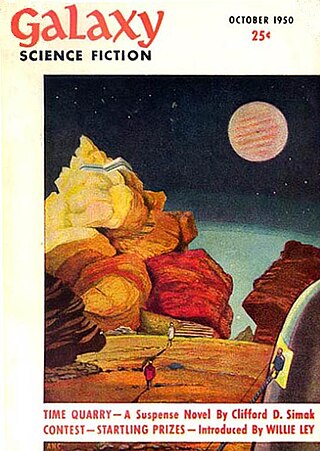
Galaxy Science Fiction was an American digest-size science fiction magazine, published in Boston from 1950 to 1980. It was founded by a French-Italian company, World Editions, which was looking to break into the American market. World Editions hired as editor H. L. Gold, who rapidly made Galaxy the leading science fiction magazine of its time, focusing on stories about social issues rather than technology.
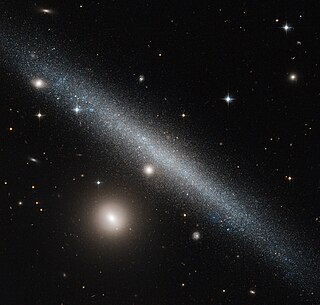
The Uppsala General Catalogue of Galaxies (UGC) is a catalogue of 12,921 galaxies visible from the northern hemisphere. It was first published in 1973.
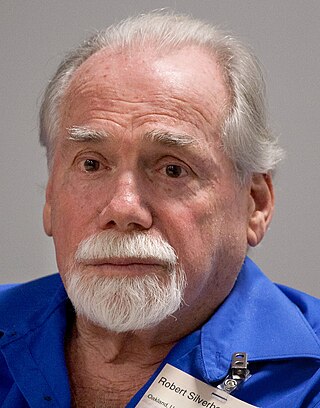
Robert Silverberg is an American author and editor, best known for writing science fiction. He is a multiple winner of both Hugo and Nebula Awards, a member of the Science Fiction and Fantasy Hall of Fame, and a Grand Master of SF. He has attended every Hugo Award ceremony since the inaugural event in 1953.

Harlow Shapley was an American scientist, head of the Harvard College Observatory (1921–1952), and political activist during the latter New Deal and Fair Deal.

Jan Hendrik Oort was a Dutch astronomer who made significant contributions to the understanding of the Milky Way and who was a pioneer in the field of radio astronomy. The New York Times called him "one of the century's foremost explorers of the universe"; the European Space Agency website describes him as "one of the greatest astronomers of the 20th century" and states that he "revolutionised astronomy through his ground-breaking discoveries." In 1955, Oort's name appeared in Life magazine's list of the 100 most famous living people. He has been described as "putting the Netherlands in the forefront of postwar astronomy."

Vera Florence Cooper Rubin was an American astronomer who pioneered work on galaxy rotation rates. She uncovered the discrepancy between the predicted and observed angular motion of galaxies by studying galactic rotation curves. By identifying the galaxy rotation problem, her work provided evidence for the existence of dark matter. These results were later confirmed over subsequent decades.

Rashid Alievich Sunyaev is a German, Soviet, and Russian astrophysicist of Tatar descent. He got his MS degree from the Moscow Institute of Physics and Technology (MIPT) in 1966. He became a professor at MIPT in 1974. Sunyaev was the head of the High Energy Astrophysics Department of the Russian Academy of Sciences, and has been chief scientist of the Academy's Space Research Institute since 1992. He has also been a director of the Max Planck Institute for Astrophysics in Garching, Germany since 1996, and Maureen and John Hendricks Distinguished Visiting Professor in the School of Natural Sciences at the Institute for Advanced Study in Princeton since 2010.

Vesto Melvin Slipher was an American astronomer who performed the first measurements of radial velocities for galaxies. He was the first to discover that distant galaxies are redshifted, thus providing the first empirical basis for the expansion of the universe. He was also the first to relate these redshifts to velocity.

Allan Rex Sandage was an American astronomer. He was Staff Member Emeritus with the Carnegie Observatories in Pasadena, California. He determined the first reasonably accurate values for the Hubble constant and the age of the universe.

Guardians of the Galaxy are a superhero team appearing in American comic books published by Marvel Comics. The Guardians first appear in Marvel Super-Heroes #18. The initial roster consisted of Vance Astro, Martinex T'Naga, Captain Charlie-27, and Yondu Udonta. Later members included Stakar Ogord, Aleta Ogord, and Nikki.

James Edward Gunn is the Eugene Higgins Professor of Astronomy at Princeton University. Gunn's early theoretical work in astronomy has helped establish the current understanding of how galaxies form, and the properties of the space between galaxies. He also suggested important observational tests to confirm the presence of dark matter in galaxies, and predicted the existence of a Gunn–Peterson trough in the spectra of distant quasars.

The Milky Way is the galaxy that includes the Solar System, with the name describing the galaxy's appearance from Earth: a hazy band of light seen in the night sky formed from stars that cannot be individually distinguished by the naked eye. The term Milky Way is a translation of the Latin via lactea, from the Greek γαλαξίας κύκλος, meaning "milky circle". From Earth, the Milky Way appears as a band because its disk-shaped structure is viewed from within. Galileo Galilei first resolved the band of light into individual stars with his telescope in 1610. Until the early 1920s, most astronomers thought that the Milky Way contained all the stars in the Universe. Following the 1920 Great Debate between the astronomers Harlow Shapley and Heber Doust Curtis, observations by Edwin Hubble showed that the Milky Way is just one of many galaxies.
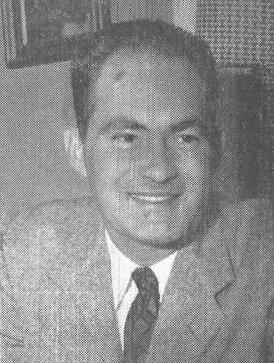
Richard Wilson was an American science fiction writer and fan. He was a member of the Futurians, and was married for a time to Leslie Perri, who had also been a Futurian.

Reinhard Genzel is a German astrophysicist, co-director of the Max Planck Institute for Extraterrestrial Physics, a professor at LMU and an emeritus professor at the University of California, Berkeley. He was awarded the 2020 Nobel Prize in Physics "for the discovery of a supermassive compact object at the centre of our galaxy", which he shared with Andrea Ghez and Roger Penrose. In a 2021 interview given to Federal University of Pará in Brazil, Genzel recalls his journey as a physicist; the influence of his father, Ludwig Genzel; his experiences working with Charles H. Townes; and more.
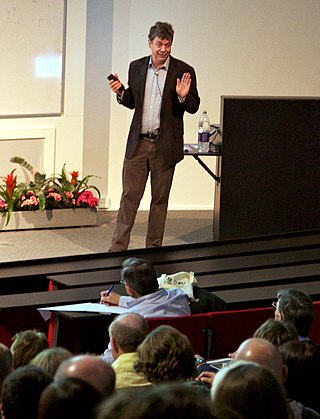
Simon David Manton White, FRS, is a British-German astrophysicist. He was one of directors at the Max Planck Institute for Astrophysics before his retirement in late 2019.



















